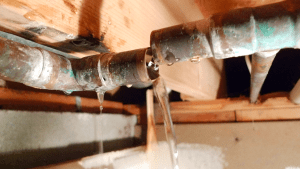6 Ways to Locate Hidden Water Leakages in Your Residence
6 Ways to Locate Hidden Water Leakages in Your Residence
Blog Article
This post which follows on the subject of Leaking water lines is seriously interesting. Give it a try and make your own personal ideas.

Early discovery of leaking water lines can mitigate a potential disaster. Some small water leakages may not be visible.
1. Examine the Water Meter
Every residence has a water meter. Examining it is a guaranteed manner in which assists you discover leakages. For starters, switch off all the water sources. Make certain no one will certainly flush, utilize the tap, shower, run the washing maker or dishwasher. From there, go to the meter as well as watch if it will certainly change. Considering that no one is utilizing it, there must be no movements. If it moves, that shows a fast-moving leak. If you find no changes, wait an hour or two and also examine back again. This indicates you might have a slow-moving leak that could even be below ground.
2. Examine Water Intake
If you spot sudden changes, despite your consumption being the same, it means that you have leakages in your plumbing system. An abrupt spike in your costs shows a fast-moving leakage.
On the other hand, a steady increase every month, despite having the very same behaviors, reveals you have a sluggish leak that's also gradually rising. Call a plumber to thoroughly examine your building, specifically if you feel a warm location on your flooring with piping underneath.
3. Do a Food Coloring Examination
When it comes to water consumption, 30% comes from commodes. If the color in some way infiltrates your bowl throughout that time without flushing, there's a leak in between the container as well as bowl.
4. Asses Outside Lines
Don't neglect to inspect your outside water lines too. Needs to water seep out of the connection, you have a loose rubber gasket. One small leakage can lose tons of water as well as increase your water bill.
5. Examine the scenario and evaluate
Home owners need to make it a behavior to examine under the sink counters and even inside closets for any bad odor or mold and mildew development. These two red flags show a leakage so prompt attention is required. Doing routine assessments, also bi-annually, can conserve you from a significant trouble.
Examine for stainings as well as weakening as most pipelines as well as appliances have a life expectancy. If you believe dripping water lines in your plumbing system, don't wait for it to rise.
Early discovery of leaking water lines can minimize a possible catastrophe. Some small water leakages might not be visible. Examining it is a guaranteed way that aids you find leaks. One little leak can waste bunches of water as well as increase your water bill.
If you believe leaking water lines in your plumbing system, don't wait for it to intensify.
WARNING SIGNS OF WATER LEAKAGE BEHIND THE WALL
PERSISTENT MUSTY ODORS
As water slowly drips from a leaky pipe inside the wall, flooring and sheetrock stay damp and develop an odor similar to wet cardboard. It generates a musty smell that can help you find hidden leaks.
MOLD IN UNUSUAL AREAS
Mold usually grows in wet areas like kitchens, baths and laundry rooms. If you spot the stuff on walls or baseboards in other rooms of the house, it’s a good indicator of undetected water leaks.
STAINS THAT GROW
When mold thrives around a leaky pipe, it sometimes takes hold on the inside surface of the affected wall. A growing stain on otherwise clean sheetrock is often your sign of a hidden plumbing problem.
PEELING OR BUBBLING WALLPAPER / PAINT
This clue is easy to miss in rooms that don’t get much use. When you see wallpaper separating along seams or paint bubbling or flaking off the wall, blame sheetrock that stays wet because of an undetected leak.
BUCKLED CEILINGS AND STAINED FLOORS
If ceilings or floors in bathrooms, kitchens or laundry areas develop structural problems, don’t rule out constant damp inside the walls. Wet sheetrock can affect adjacent framing, flooring and ceilings.
https://www.servicemasterbyzaba.com/blog/how-to-detect-water-leakage-in-walls/

Hopefully you enjoyed reading our topic on Leaking water lines. Thanks a lot for taking time to browse our content. Be sure to take the opportunity to share this blog if you enjoyed reading it. We thank you for reading our article about Hacks to detect leaks.
Report this page